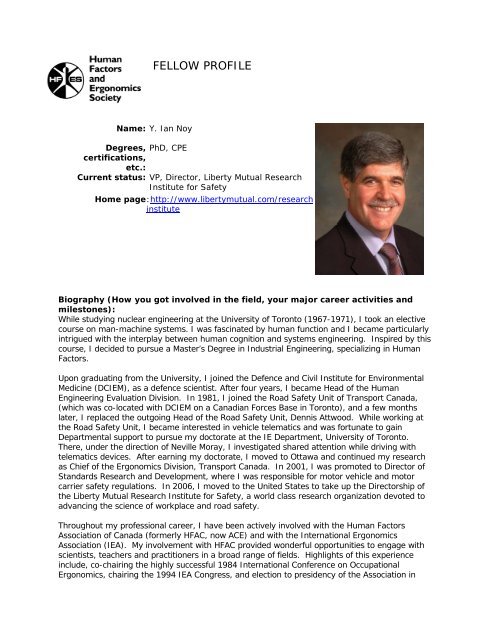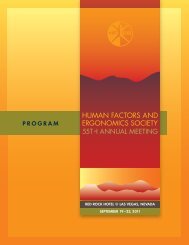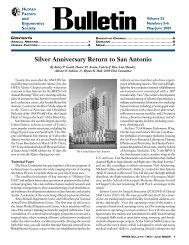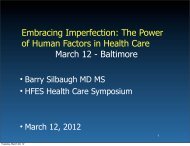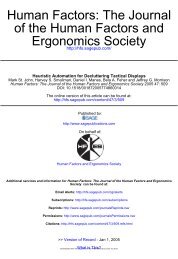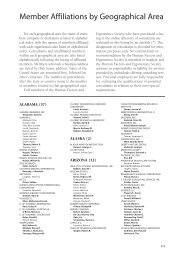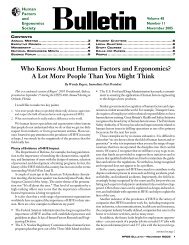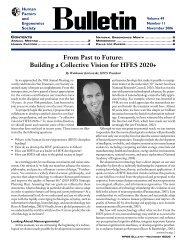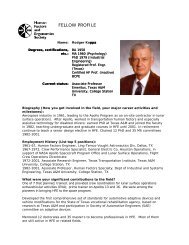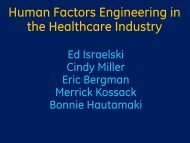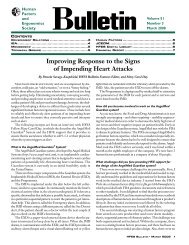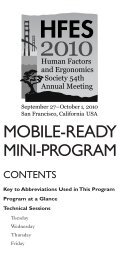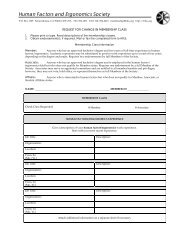Y. Ian Noy - Human Factors and Ergonomics Society
Y. Ian Noy - Human Factors and Ergonomics Society
Y. Ian Noy - Human Factors and Ergonomics Society
Create successful ePaper yourself
Turn your PDF publications into a flip-book with our unique Google optimized e-Paper software.
FELLOW PROFILE<br />
Name: Y. <strong>Ian</strong> <strong>Noy</strong><br />
Degrees, PhD, CPE<br />
certifications,<br />
etc.:<br />
Current status: VP, Director, Liberty Mutual Research<br />
Institute for Safety<br />
Home page :http://www.libertymutual.com/research<br />
institute<br />
Biography (How you got involved in the field, your major career activities <strong>and</strong><br />
milestones):<br />
While studying nuclear engineering at the University of Toronto (1967-1971), I took an elective<br />
course on man-machine systems. I was fascinated by human function <strong>and</strong> I became particularly<br />
intrigued with the interplay between human cognition <strong>and</strong> systems engineering. Inspired by this<br />
course, I decided to pursue a Master’s Degree in Industrial Engineering, specializing in <strong>Human</strong><br />
<strong>Factors</strong>.<br />
Upon graduating from the University, I joined the Defence <strong>and</strong> Civil Institute for Environmental<br />
Medicine (DCIEM), as a defence scientist. After four years, I became Head of the <strong>Human</strong><br />
Engineering Evaluation Division. In 1981, I joined the Road Safety Unit of Transport Canada,<br />
(which was co-located with DCIEM on a Canadian Forces Base in Toronto), <strong>and</strong> a few months<br />
later, I replaced the outgoing Head of the Road Safety Unit, Dennis Attwood. While working at<br />
the Road Safety Unit, I became interested in vehicle telematics <strong>and</strong> was fortunate to gain<br />
Departmental support to pursue my doctorate at the IE Department, University of Toronto.<br />
There, under the direction of Neville Moray, I investigated shared attention while driving with<br />
telematics devices. After earning my doctorate, I moved to Ottawa <strong>and</strong> continued my research<br />
as Chief of the <strong>Ergonomics</strong> Division, Transport Canada. In 2001, I was promoted to Director of<br />
St<strong>and</strong>ards Research <strong>and</strong> Development, where I was responsible for motor vehicle <strong>and</strong> motor<br />
carrier safety regulations. In 2006, I moved to the United States to take up the Directorship of<br />
the Liberty Mutual Research Institute for Safety, a world class research organization devoted to<br />
advancing the science of workplace <strong>and</strong> road safety.<br />
Throughout my professional career, I have been actively involved with the <strong>Human</strong> <strong>Factors</strong><br />
Association of Canada (formerly HFAC, now ACE) <strong>and</strong> with the International <strong>Ergonomics</strong><br />
Association (IEA). My involvement with HFAC provided wonderful opportunities to engage with<br />
scientists, teachers <strong>and</strong> practitioners in a broad range of fields. Highlights of this experience<br />
include, co-chairing the highly successful 1984 International Conference on Occupational<br />
<strong>Ergonomics</strong>, chairing the 1994 IEA Congress, <strong>and</strong> election to presidency of the Association in
1981. My involvement in the IEA began in 1981 when, as President of HFAC, I attended the IEA<br />
Council meeting in Rochester, NY. The following year, I attended the Tokyo IEA Congress,<br />
where Hal Hendrick introduced a new branch of ergonomics --macroergonomics-- to the IEA In<br />
1983, Hal <strong>and</strong> I chaired two ad hoc committees of the IEA. This led to two significant personal<br />
milestones: a close collaboration <strong>and</strong> friendship with Hal Hendrick, <strong>and</strong> a 20-year involvement<br />
on the IEA Executive, culminating in my presidency 1997-2000.<br />
Through my involvement in HFAC <strong>and</strong> IEA, I have been given many exceptional opportunities to<br />
serve the profession, <strong>and</strong> I have been exposed to many diverse perspectives that have enriched<br />
my career. In addition, I have befriended <strong>and</strong> worked with many people across the globe who<br />
have had a profound impact on me personally <strong>and</strong> professionally. I am grateful to a multitude<br />
of colleagues, mentors <strong>and</strong> friends who have inspired me, challenged me, <strong>and</strong> helped me in<br />
what continues to be supremely rewarding career.<br />
Employment History (List top 5 positions):<br />
1. 2006-Present, Vice President Liberty Mutual Group <strong>and</strong> Director, Liberty Mutual<br />
Research Institute for Safety, 71 Frankl<strong>and</strong> Rd., Hopkinton, MA 01748.<br />
Responsible for overall direction <strong>and</strong> management of the organization’s scientific<br />
research aimed at the reduction <strong>and</strong> mitigation of occupational injuries, including<br />
oversight of the Institute’s Center for Injury Epidemiology, the Center for Physical<br />
<strong>Ergonomics</strong>, the Center for Behavioral Sciences <strong>and</strong> the Center of Disability<br />
Research, as well as extramural/collaborative research.<br />
2. 2002-2006, Director, St<strong>and</strong>ards Research <strong>and</strong> Development, Road Safety<br />
Directorate, Transport Canada, 330 Sparks St., Ottawa. Responsible for motor<br />
vehicle safety regulations; ergonomics, crashworthiness <strong>and</strong> vehicle systems<br />
research; <strong>and</strong> motor carrier safety.<br />
3. 1982-2006, President <strong>and</strong> principal consultant, Systems <strong>Ergonomics</strong> Inc. Provided<br />
professional consulting services in a broad range of areas including, forensic<br />
analysis in cases involving personal injury arising from human-system failures,<br />
expert testimony in aid of civil or criminal litigation, workplace assessment, task<br />
analysis, specification of user interface design, <strong>and</strong> related research.<br />
4. 1982-2002, Chief, <strong>Ergonomics</strong> Division, Transport Canada, 344 Slater St., Ottawa.<br />
Responsible for directing the operation <strong>and</strong> research of the Division, including<br />
human factors research to support the development of vehicle safety st<strong>and</strong>ards <strong>and</strong><br />
a variety of other accident countermeasures. During 1995-1998, also responsible<br />
for the management of the Vehicle Systems Division which conducted research in<br />
biomechanics <strong>and</strong> crashworthiness, heavy vehicle crash avoidance <strong>and</strong> other areas<br />
relevant to motor vehicle safety.<br />
5. 1977-1981, Head of Evaluation Group, <strong>Human</strong> Engineering Section, Behavioural<br />
Sciences Division, Defence <strong>and</strong> Civil Institute of Environmental Medicine, (DCIEM,<br />
North York, Ontario). Responsible for the research of five scientists, including<br />
planning <strong>and</strong> directing human engineering studies to support research <strong>and</strong><br />
development of military man-machine systems as well as conducting independent<br />
research into a variety of military problems. Represented DCIEM on international<br />
st<strong>and</strong>ardization committees.
What were your significant contributions to the field?<br />
I have authored over 130 technical reports <strong>and</strong> publications <strong>and</strong> reviewed numerous<br />
scientific <strong>and</strong> technical reports. I was lead Editor, H<strong>and</strong>book of <strong>Human</strong> <strong>Factors</strong> in<br />
Litigation, 2004, CRC Press. I also edited <strong>Ergonomics</strong> <strong>and</strong> Safety of Intelligent Driver<br />
Interfaces, 1997, Lawrence Erlbaum Associates. I also initiated <strong>and</strong> spearheaded the<br />
effort to formulate <strong>and</strong> adopt the IEA definition of <strong>Ergonomics</strong> (<strong>Human</strong> <strong>Factors</strong>).<br />
Did you receive any notable awards or recognition during your career?<br />
U.S. National Highway Traffic Safety Administration’s Engineering Excellence Award<br />
Distinguished Service Award, International <strong>Ergonomics</strong> Association<br />
<strong>Human</strong> <strong>Factors</strong> <strong>and</strong> <strong>Ergonomics</strong> <strong>Society</strong>’s Distinguished International Colleague<br />
Award<br />
Prof. Wojciech Bogumit Jastrzebowski Medal of the Polish <strong>Ergonomics</strong> <strong>Society</strong><br />
Guest Professorship, Department of Industrial Engineering, Tsinghua University, PR<br />
China<br />
Fellow of the International <strong>Ergonomics</strong> Association<br />
Fellow of the <strong>Human</strong> <strong>Factors</strong> <strong>and</strong> <strong>Ergonomics</strong> <strong>Society</strong><br />
Honorary Fellow of the Association of Canadian Ergonomists/Association canadienne<br />
d'ergonomie<br />
Deputy Minister Commendation for Excellence, Transport Canada<br />
Delegation Leader, <strong>Ergonomics</strong> Delegation to the People’s Republic of China, People<br />
to People Ambassador Programs<br />
Which articles in the journal <strong>Human</strong> <strong>Factors</strong> would you say were the most<br />
influential to you <strong>and</strong> your research or practice?<br />
The articles of most interest to me were those dealing with transportation safety. Over<br />
the years there have been numerous excellent articles in this area, too numerous to list.<br />
Please provide any links to your online articles, essays, blogs, Wikipedia pages,<br />
etc., that pertain to your research, publications or practice.<br />
www.libertymutualgroup.com/researchinstitute<br />
http://www.crcpress.com/product/isbn/9780415288705<br />
What advice would you give someone considering HF/E as a profession?<br />
When I look back at my career, I realize that many of the positive developments came<br />
about as a result of chance encounters <strong>and</strong> opportunities that emerged long after the<br />
seeds were unwittingly planted. My advice is to keep an open mind, stay current with<br />
developments in the field, pursue directions where you have true passion, take risks, <strong>and</strong><br />
network extensively. I was fortunate throughout my career to have the latitude to pursue<br />
my passion, often in organizations <strong>and</strong> environments that are not considered overly<br />
stimulating. But the organizational environment played a very small part of my career<br />
trajectory. I was motivated from within <strong>and</strong> reaped rewards from colleagues far <strong>and</strong> wide.<br />
I realize that I was privileged to have the discretion to pursue my extramural activities<br />
having gained the trust <strong>and</strong> confidence of my employers.<br />
So, the most important advice is to take responsibility for your own development relying<br />
on hard work <strong>and</strong> good fortune – the former is entirely within one’s control; the latter is<br />
often spurred by the former.


